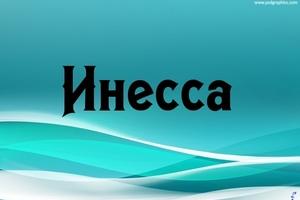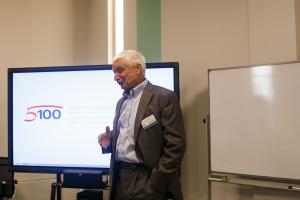Page 18 of 23
LESSON 14
Warm-up
- Name Aibolit’s profession (animal doctor or veterinarian)
- What a shameless animal.. (wolf)
- His writer Nosov sent him to the moon. (Dunno)
- Who was the prince from Cippolino's fairy tale? (Cherry)
- Three Little Pigs: Naf-Naf, Nuf-Nuf and Nif-Nif.
- What was the name of the old woman’s favorite animal, Shapoklyak? (Shushara)
- Who is Ivanushka? (brother)
- What is the name of the island where Prince Guidon lived? (Brawler)
- “Sivka-Burka, prophetic kaurka, stand in front of me like a leaf in front of the grass.”
- Who was as tall as a finger? (Tom Thumb).
2. Look carefully at the images and write what they look like.
There can be a variety of answers, for example, in this picture you can see smoke, an aquarium with water, a dog’s head, a man in a hat, etc.
4. Guess what words are hidden in the pictures.
Answer: watch, iron, goose.
5. Look carefully at the image. What is the sum of all the numbers?
Answer: 3+0+6+9+1+0+2+8+5+4+7=45
6. Think about what might be in common between the image of a boy and other objects? Connect with arrows.
- The table has legs, just like the boy,
- The door has handles, just like the boy,
- The decanter has a neck, just like the boy.
- The kettle has a spout and handle, just like the boy
- The hanger has hangers, just like the boy
- The chair has a back and legs, just like the boy's
- The shoe has a tongue, just like the boy
- The needle has an eye, just like the boy
Humanity has achieved everything that it is at the moment, not only thanks to its physical abilities, the basis of all discoveries and inventions has become mental activity. Nowadays, there are many diseases and deviations from normal development that can be diagnosed and treated. And psychological testing helps identify many problems with mental activity.
Comparison method
The basis of psychological testing included the main ones such as analysis, comparison, synthesis, generalization, abstraction and specification. All of them are capable of showing different aspects of the basic activity of human thinking.
Through comparison, a person is able to compare objects and phenomena in order to find similarities and differences between them. While searching for similarities, you may notice that many objects are similar in one way and different in another, and some have nothing in common. But similarity or difference is determined depending on what characteristics of the object are significant in a given period of time. Very often a person perceives the same things and actions differently, depending on the situation.
Comparison tests, or What do a pencil and a shoe have in common?
Throughout life, first at school, then at a higher educational institution and sometimes when entering a job, a person is asked to take this test. In childhood, using the concepts of comparison, children are tested for the development of their creative potential and determined what kind of thinking prevails in the child. At a more mature age, this test can be offered to check how healthy a person’s thinking is.
Categories of words in the test
One of the most common questions in this case is the comparison of disparate items. A. R. Lury suggests dividing these words into three different categories. The simplest of them is a comparison of two words belonging to the same category, for example, tram - bus or horse - cow.

In the second category, more complex comparisons predominate, they are more different than the same. An example of such a comparison is “crow - fish”. The third group is the most difficult. It presents different concepts, and comparing them should cause mental conflict. That is, their differences are stronger than their similarities. For example, what do a pencil and a shoe have in common?
The operational side of thinking and its violations
If a person experiences a decrease in the functions responsible for the level of generalization in judgments, then he begins to evaluate objects and phenomena quite extensively. In other words, instead of highlighting some general feature, they select a specific situation. That is, if you compare a book and a sofa, an unhealthy person will say that you can read it on it, without taking into account factors that for a normal person will be more logical and reflect the specific similarities of these objects. The main reasons for the decline in such thinking are epilepsy, damage to the central nervous system and problems after a head injury. Using psychological testing, one also checks whether the generalization process is distorted.

In this case, one can notice that a person is looking for overly generalized signs between objects, without seeing the most important similarity. Basically, the affected consciousness tries to avoid performing the assigned tasks, starting to search for formal, completely random associations. At the same time, they completely do not take into account real similarities and differences, not using them as control and verification of their own judgments. As an example of what a pencil and a shoe have in common, it is more often said that they leave marks. Such disturbances in the thought process characterize schizophrenia. But it is worth noting that this is not a necessary sign of a mental disorder. A similar answer can also be given by a person with a width slightly wider than that of ordinary people.
Examples of answers to the question about what a pencil and a shoe have in common (schizophrenia)
Some of the people's responses were recorded. When considering the various concepts of people with schizophrenia, one can see a detached perception and overly abstract concepts. When comparing two vehicles, a bus and a tram, patients note the presence of windows, wheels and various stops. When it comes to comparing animals such as mice and cats, unhealthy people point out that they are trainable, can see in the dark and are used for scientific purposes, completely missing the main signs of similarity. When asked the most common question about what is common between a pencil and a shoe, patients highlight similarities such as leaving marks, reproducing sounds and the presence of rubber in the structure.

When comparing a boat and a plate, a person with impaired thinking pays attention to such properties as the ability to not allow liquid to pass through and the likelihood that these two objects can break, or they talk about the inedibility of these objects. Having asked the patient to compare a globe and a butterfly, the scientists received the following answer: the ability to spin in one place or the symmetry of objects. But in fact, he will answer that these concepts have nothing in common. Comparing a cloak and the night, patients with schizophrenia note the appearance of these objects in the absence of light and their ability to hide the outlines of figures. When comparing a clock and a river, it is said that these two objects can be changed by man, can go in a vicious circle, and also note their connection with infinity.
Conclusion
Many similar answers can be given, but it is worth considering that a healthy person will answer such questions as “what is common between a rooster and a glass” that they are incomparable. But the patient will try to find signs that make these concepts similar. For example, he will highlight that it belongs to the kitchen or will pay attention to the presence of ribs (specifying that the glass is faceted).

In any case, such tests must be carried out comprehensively, and only then can the true ones be identified and a clear description of what exactly is damaged in a person’s consciousness possible. Answering only some questions makes it impossible to see the whole picture.
One summer, several of my friends and I went to work part-time at a construction site. There I periodically met engineers who were closely studying some maps in their hands. These maps were topographical plans and showed the location of future structures. For builders and industrialists, plans are everything, and the globe is just a toy in the geography classroom.
What is a globe and why was it invented?
The first globe was created by Crates of Mallus in 150 BC.
A globe is a miniature model of the Earth that accurately recreates its shape and can show the rotation of the planet around its axis.
The Earth model is useful for visually demonstrating the exact locations of continents, oceans, islands and rivers in educational settings. Using it, you can show the daily rotation of the Earth, the result of which is the change of day and night.
Topographic plan
This is a diagram on which a small part of the Earth’s surface is projected and all those objects that are present in reality are applied using symbols.
Plans are drawn up on large scales, starting from 1:2000. The average scale of the globe is 1:1000000, so it cannot be called a detailed source of cartographic information.
What is common between the image of the earth's surface on a globe and on a plan?
Globes and plans are similar to each other in the following ways:
- they are marked with symbols and a grid of geographic coordinates, which is necessary in the process of searching for any point on Earth;
- both are created to scale in relation to real distances, but the plan gives details, and the globe gives a general view from space;
- no distortion. Unlike a globe, maps and plans distort real distances, but on plans the distortion, due to the large scale, is insignificant.
If you create a plan in the form of a globe, then at the smallest scale (1:2000) you will get a ball with a circumference of 20 km - this is 2 times the circumference of the Moon.
Modern computer technologies can fit any fragment of a map or plan to the shape of a fragment of the Earth, thereby eliminating all possible distortions.
stepbystep_hdr In one of his recent posts, he published a number of paintings by an American landscape painter of the 19th century. Frederic Edwin Chech. Looking through his paintings, I was once again convinced of how much there is in common between photography and painting, and how useful painting can be for a landscape photographer (and not only for landscape painters).In the age of digital photography with its flow of photographs, the ocean of “photos” and “photos”, it is useful to look at the canvases of artists from whom owners of a modern digital camera can learn a lot. Below is my thoughts on this matter...
What attracted me to the artist’s paintings first of all were the shadows - deep, black and most importantly - they are where they should be based on the lighting! For example, like on these canvases:
1.
2.
3.
There is no need to be afraid of shadows in your photographs - and in the last photo tour I just noticed, if not fear, then a persistent desire of some participants to “stretch them out” as much as possible. There is no need to “pull” them in Photoshop, pull out details that often carry absolutely no meaning and only “overload” the photo. In a word, you should not overuse CDR (hello to avid CDR users, especially fans of in-camera CDR! :))), obtaining completely flat and unnatural images for the eye. Shadows, like light, create volume in a photograph (as in the paintings shown). To some extent, in photography we “paint” not only with light, but also with shadow. The pictures given as examples demonstrate just this. Of course, CDR is a useful technique, the use of which in many cases is simply necessary, but you need to use moderation!...
Further. The sun and its position in the frame. Pay attention to the pictures below. The artist does not depict the sun high above the horizon when it reaches its maximum brightness. On the contrary, he chooses the pre-sunset/evening or morning hours, when the sun is at the horizon (essentially, this is the regime time in photography). In addition, the sunlight in the author’s paintings is dissipated by light clouds and haze:
4.
5.
What does this give? This allows you to convey soft, diffused light filled with colors. This is an important point to remember when photographing landscapes. Avoid hard light and too much sun - it will simply burn a hole in your photo. And no amount of exposure bracketing (XDR) will save you. But diffused sunlight impresses with its abundance of colors, giving us the lighting and “soft” shadows we need. It is no coincidence that landscape painters shoot early in the morning, at dawn or sunset...
And one last thing. Colors. I would like to draw attention, for example, to the shades of green in this picture:
6.
There are no poisonous (“gouge-eyed”) green flowers of leaves of trees and plants, which are replete with the Internet, and which are often abused especially by beginners in photography. On the contrary, the eye is pleased with the natural shades of green in all their diversity, favorably emphasized by the light-shadow pattern. Personally, I like to look at this color. As for me, it is very harmonious and “deep” (if, of course, you can put it that way). In short, you need to develop a sense of aesthetics by looking at the works of artists - they can teach you a lot.
If there are any additions, comments, suggestions, etc. - please feel free to write in the comments, don’t be shy :))
My previous posts on the topic of landscape photography.








